This article explains how to activate the parental control feature on Android and select appropriate levels of restrictions for content such as applications, games, movies, TV, magazines and music. Parental control allows you to restrict what can be installed and used on the device based on official ratings and levels. Alternatively, on some Android phones and tablets you can create restricted profiles using the "Settings" menu.
Steps
Method 1 of 2: Turn on Parental Control

Step 1. Open the Google Play Store
on your device.
Look for the Play Store icon on the Home screen or in the application menu.
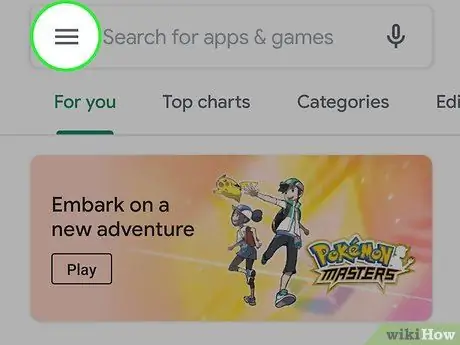
Step 2. Press the menu button, which looks like three dashes ☰
This button is located in the upper left corner of the screen and will allow you to open the navigation menu.
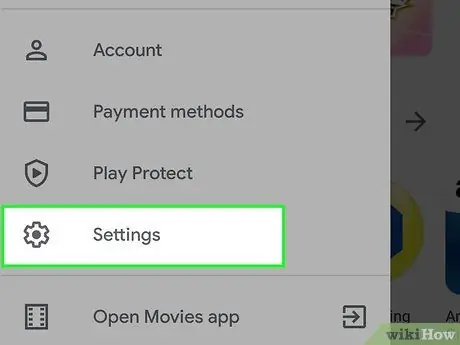
Step 3. Select Settings from the menu
This will open the "Settings" menu on a new page.

Step 4. Scroll down and select Parental Controls
This option is found in the "Settings" menu, under "User Controls".
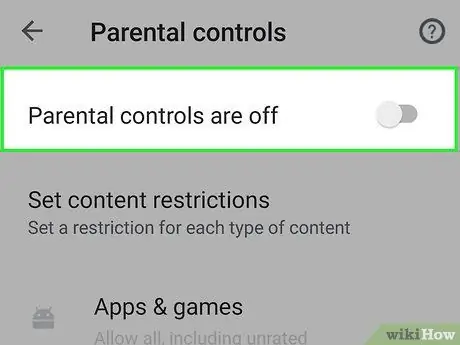
Step 5. Swipe the switch next to the "Parental Control" option to turn it on
You will find it in the upper right corner of the page titled "Parental Controls".
At this point you will be prompted to set a PIN for the content
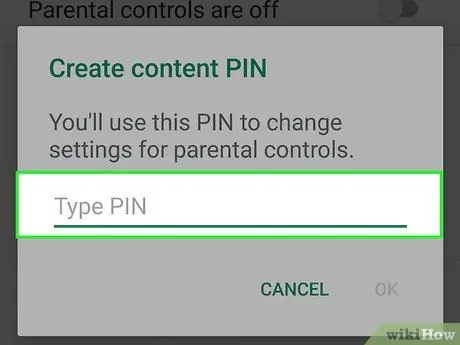
Step 6. Enter the PIN you want to use
Enter a 4-digit PIN to set parental control on the associated account.
The parental control PIN is different from that of the SIM card (which is requested on the start screen) and the screen unlock code
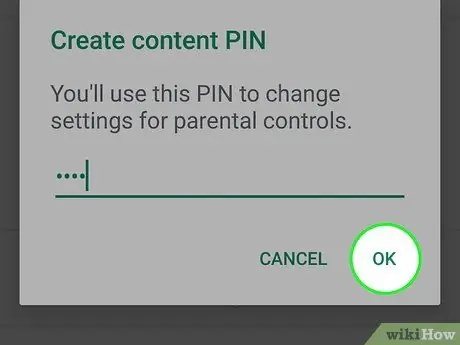
Step 7. Click on the Ok button
A pop-up will appear asking you to confirm the new PIN.
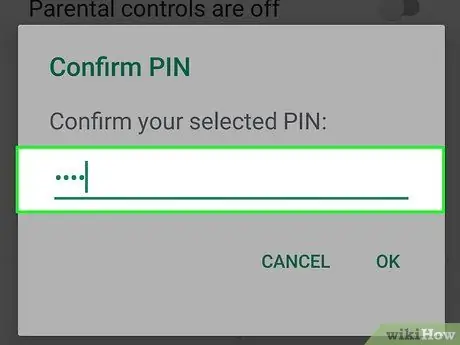
Step 8. Enter the same PIN again
Make sure you type in the exact same code to confirm it.
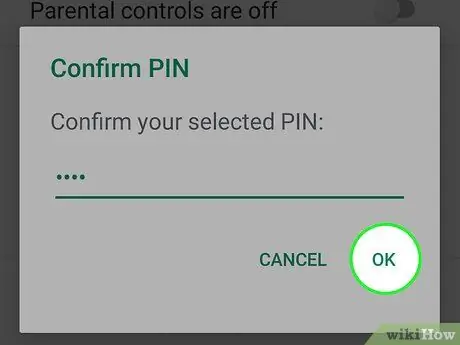
Step 9. Click Ok in the confirmation pop-up
The new PIN will then be confirmed by activating parental controls on the associated account.
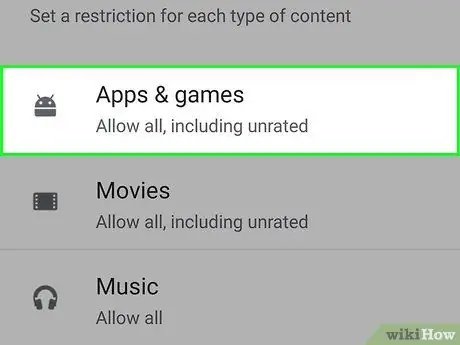
Step 10. Select Apps & Games to choose a restriction level for downloading apps
This will allow you to select a standard rating to limit the types of applications and games that can be downloaded and used.
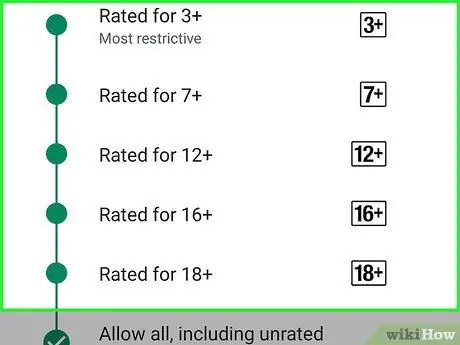
Step 11. Select the classification you want to implement for applications and games
You can choose the most restrictive option (which is at the top of the screen), the least restrictive (which is at the bottom of the screen and is called Allow all content, even unrated content) or something in between. Standard classifications include:
- For everyone (content deemed suitable for all ages);
- Age: 10+ (content deemed suitable for 10 years and over);
- Age: 13+ (content deemed suitable for ages 13 and up);
- Age: 17+ (content deemed suitable for ages 17 and up);
- Age: 18+ (content deemed suitable only for an adult audience).
- You can find all the information relating to the classifications in force in the country or geographical area where you live at the following address:
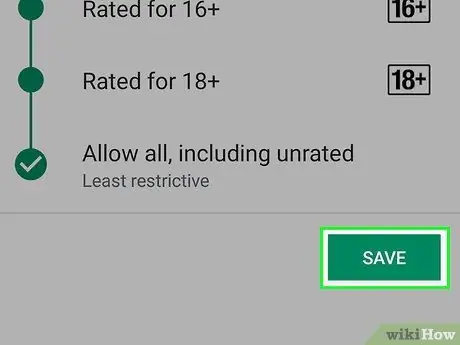
Step 12. Click on the Save button
This green button is located at the bottom of the screen. This will save the restriction level selected for all applications and for all games. At this point, you will return to the page titled "Parental Controls".
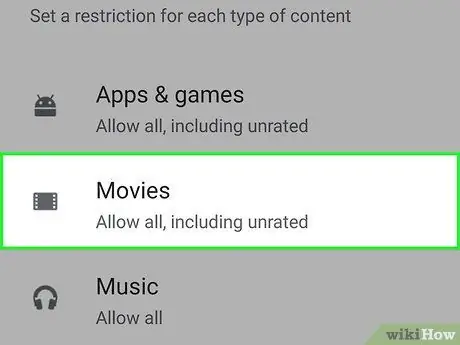
Step 13. Select Movies to restrict the download of this type of content
The list of standard classifications provided for in the country or geographic area where you are will be displayed. In Italy, the standard classifications include:
- T. (film suitable for everyone);
- VM6 (not recommended for children under 6);
- VM14 (forbidden to children under 14);
- VM18 (forbidden to minors under 18);
- There are also non-classified content, which has not been categorized by any competent authority for the distribution territory.
- Once you have selected a classification, click on Save.
- To learn more about the standard classification criteria, visit the MIBAC website.
- For more information on the classification criteria for the various countries and geographical areas, visit this site:
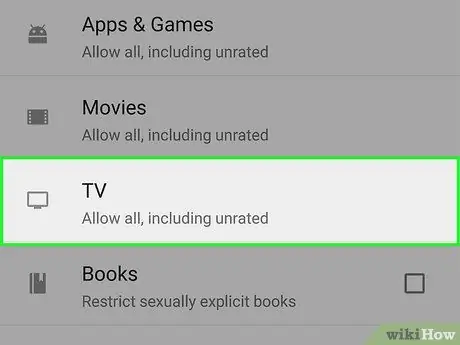
Step 14. Select TV to restrict viewing of TV programs on the associated account
This will display the classification standards provided for in the country or geographical area in which you are located. In Italy, the standard categorizations include:
- T. (film suitable for everyone);
- VM6 (not recommended for children under 6);
- VM14 (forbidden to children under 14);
- VM18 (forbidden to minors under 18);
- Once you have selected a classification, click on Save.
- In some countries and geographic areas, such as Italy, films and TV are grouped together in the same classification system.
- You can check the ratings for TV content in a particular country or region at the following link:
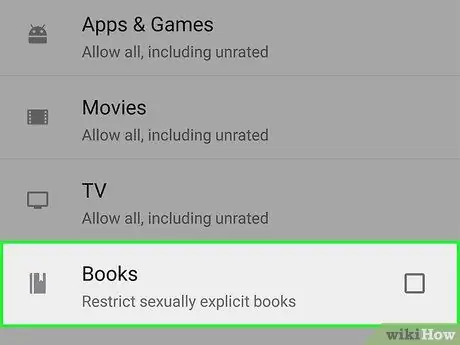
Step 15. Select Books or Magazines to enable restrictions on written content.
You can decide to restrict the download of books and magazines with adult content.
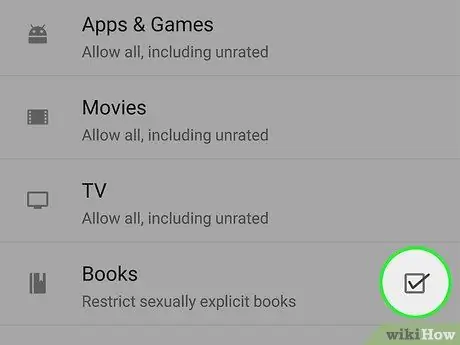
Step 16. Check the empty box
to restrict books with explicit content.
When this option is activated, the associated account will not be able to read and buy books or magazines with explicit content.
Press on Save to activate restrictions on these contents.
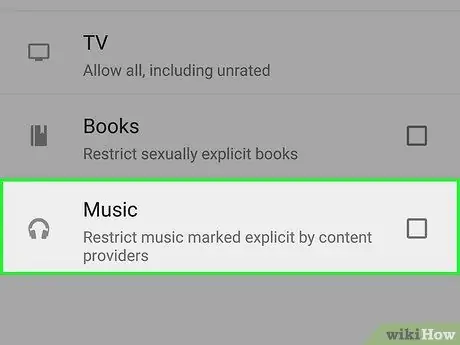
Step 17. Select Music to restrict downloads and purchases
In this section you can decide to restrict music from explicit content.

Step 18. Check the empty box
to restrict music content tagged as explicit.
This will prevent you from buying or listening to songs and albums considered explicit by distributors.
Press on Save to enable music restrictions.
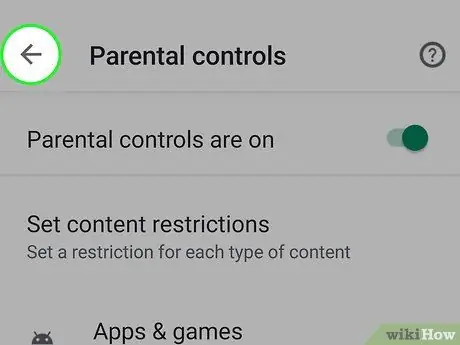
Step 19. Press the button to go back
It is located in the upper left corner of the screen. You will return to the "Settings" menu.
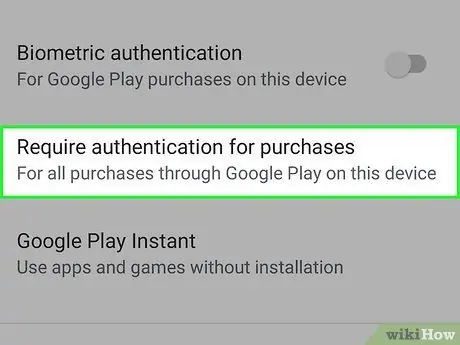
Step 20. Select Require authentication for purchases under "User Controls. This option is found on the "Settings" menu, under "Parental Controls".
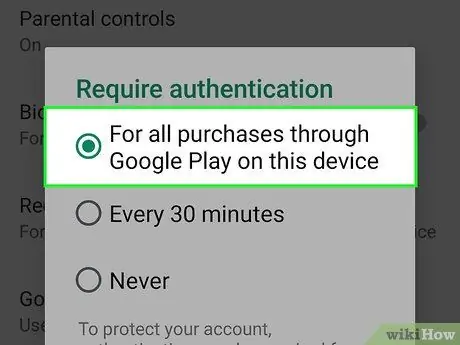
Step 21. Select For all Google Play purchases from this device in the pop-up
When this option is selected, all purchases made on the Google Play Store will require confirmation of the password.
Method 2 of 2: Create Restricted Profiles

Step 1. Open the "Settings" menu
on your device.
Locate the "Settings" icon on the application menu and tap on it. Alternatively, swipe down from the notification bar at the top of the screen and tap on the gear symbol.
- To prevent your children from using certain applications already installed on the device, it is more practical to use the restricted profiles feature than to limit the settings associated with your account on Google Play.
- Alternatively, you can download and use a third-party application such as Mobile Fence Parental Control, Kids Place or Screen Time from the Play Store.
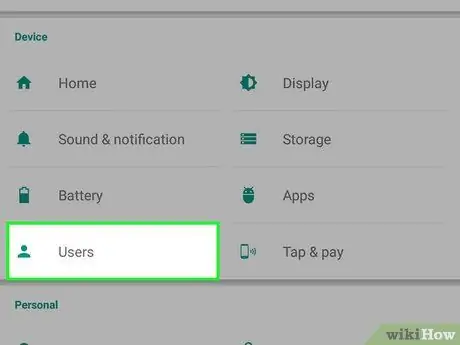
Step 2. Scroll down and select Users
This option is usually found in the section titled "Device" on the "Settings" menu. This will open a menu where you can add new profiles.
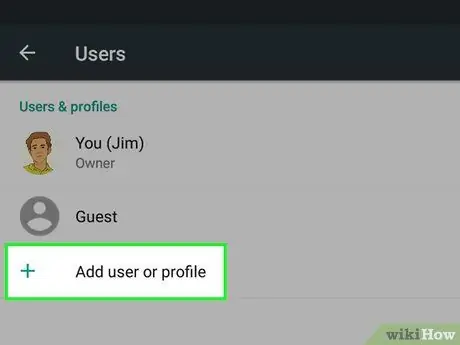
Step 3. Select + Add user or profile on the page titled "Users"
A pop-up will open, where you can view the types of users available.

Step 4. Select Restricted Profile within the pop-up
This will create a new restricted profile.
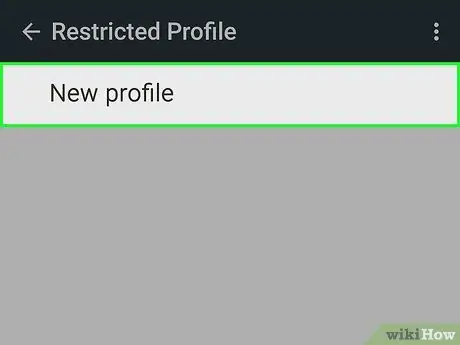
Step 5. Select the name New Profile at the top of the window
This will allow you to set a new name for the profile.
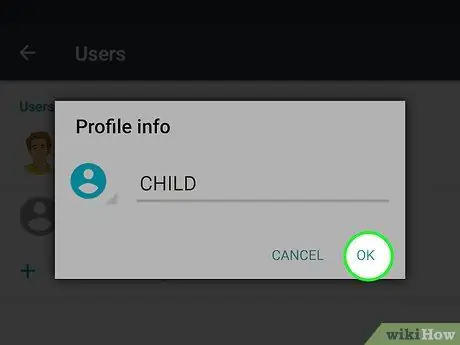
Step 6. Name the profile
Enter a username for this new restricted profile and click Ok to confirm.
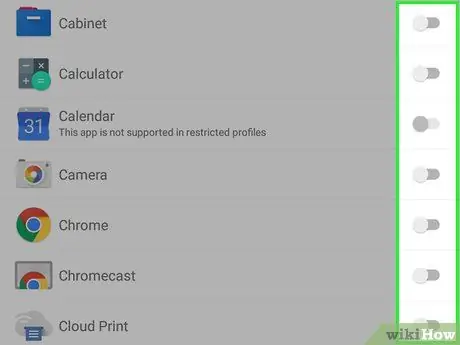
Step 7. Activate all applications you want to allow use
Click on the slider next to the applications you want to activate on the restricted profile, in order to enable them.
-
If you see an icon next to an application that looks like three lines
you can press on it and change the associated in-app settings.
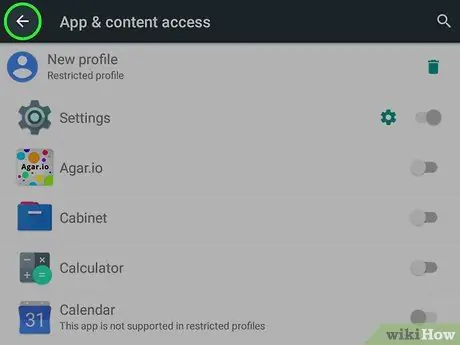
Step 8. Press the button to go back
top left.
When you have finished configuring the applications for the profile, click on the button in the upper left to return to the "Users" menu.
Now, the profile will appear on the "Users" list with its new name

Step 9. Select the restricted profile on the "Users" list
A pop-up will appear, asking you to confirm the configuration of this profile.
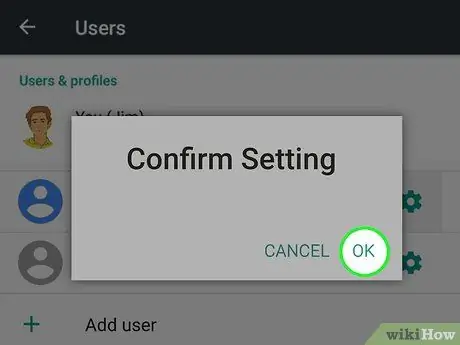
Step 10. Click Ok in the confirmation pop-up
The new profile will be set up on the device. At this point you will be redirected to the lock screen.
To use the restricted profile, you can tap on its icon at the bottom of the lock screen. Alternatively, press the admin user icon to enter the unlock code and use your personal account
Advice
- Android tablets allow you to create restricted profiles to control access to certain applications. This feature should be available from version 4.2 onwards.
- In the Play Store there are many third-party parental control applications, some free, some paid. Each application has different features, but most of them simply allow you to create a restricted profile or set a PIN code through the application itself rather than using the "Settings" menu.






